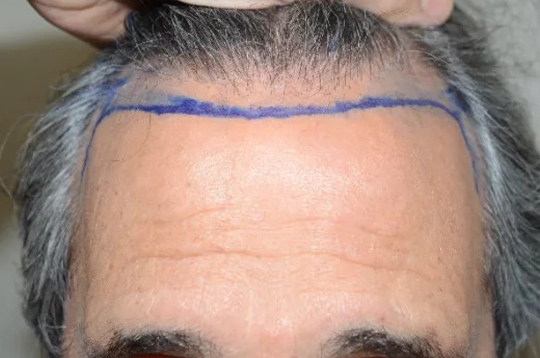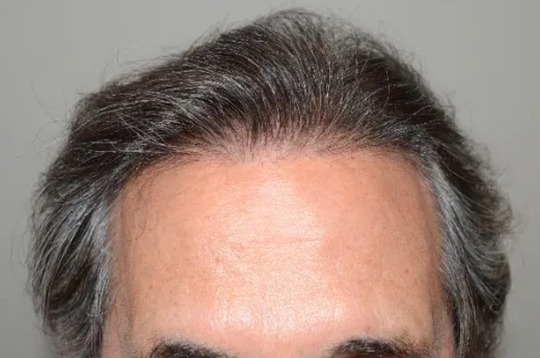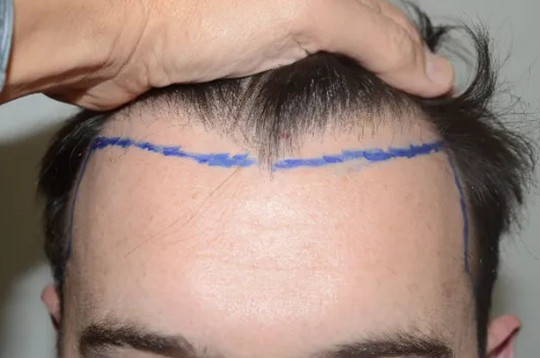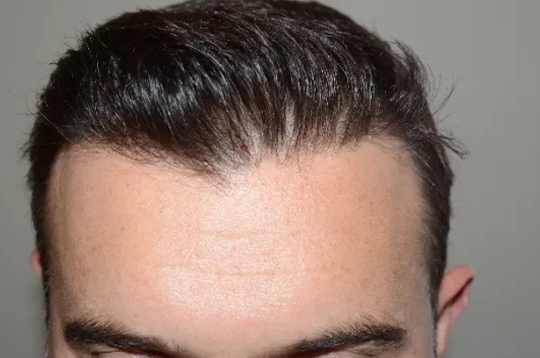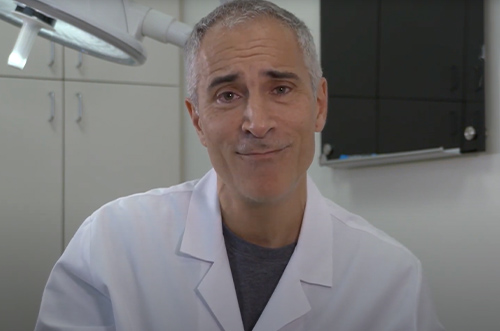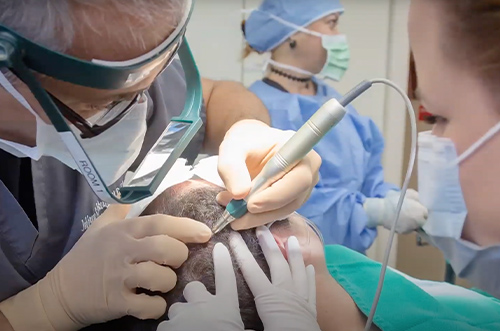Perhaps no new therapy in nearly all fields of medicine has received as much attention – and hype – as the use of growth factors for a variety of conditions that range from orthopedic to cardiac to dermatologic to neurologic and more.
Stem Cells for Hair Loss
Hair Restoration with
Fat-Derived Growth Factors
Naturally, attention has been directed towards the application of growth factors for the treatment of hair loss. In our FDA-study work on growth factors, the source of the growth factors is the patient’s own fat. And while at this point in time the FDA restricts the use of purified growth factors from being used to treat hair loss, we have recognized that fat in and of itself, as a stand-alone treatment, can be quite effective in treating hair loss.

Fat-Enhanced Hair Growth
This fat, also called adipose, when purified and injected back into the patient’s scalp along with growth factors, seems to promote hair growth in patients. This is becoming a regular procedure which we are offering, and our work in this field is receiving more and more attention as we present our results at scientific meetings. This purified fat transfer with growth factors is also an effective way to pretreat scalp scars so that hairs from a transplant will have a better rate of growth.
With this purified fat transfer procedure, a small amount of fat (40 to 100cc) is harvested using liposuction, then filtered to purify it. It is then injected along with growth factors into areas of hair loss. This combination makes great sense: the growth factors “turns up” hair follicle activity, while the purified fat supplies the energy for that growth. Fat not only contains growth factors, but it also: reduces the concentration of androgens like testosterone in tissue, increases vascularity thus increasing blood flow, and lastly suppresses inflammation which can help prevent hair loss. This entire procedure is performed under local anesthesia and if desired oral sedation, and patients are presentable the next day without any noticeable changes to the appearance of the scalp.
FACTS not FICTION ABOUT
GROWTH FACTORS
Perhaps no new therapy in nearly all fields of medicine has received as much attention – and hype – as the use of growth factors for a variety of conditions that range from orthopedic to cardiac to dermatologic to neurologic and more. Naturally, attention has been directed towards the application of growth factors for the treatment of hair loss. Herein we provide some hard facts about the state of growth factors for hair as of today. And while this info may not be quite as exciting as you had hoped, please realize that we are and will always be at the forefront of new techniques for treating hair loss.
Fact #1
Growth factors are not approved for the treatment of hair loss in the United States. To date, there has been no FDA approval for the use of growth factors for hair loss.
Fact #2
Dr. J. Epstein is currently conducting an FDA-approved study on the use of adipose-derived growth factors for the treatment of male and female pattern hair loss.
Fact #3
Approved studies are currently being conducted on the use of growth factors for other medical conditions. There are several of these approved studies going on in the US, being conducted under what is called “IRB”, or Institutional Review Board approval. These conditions include scleroderma, osteoarthritis, and diseases of the heart and neurologic system.
Latest Hair Restoration Developments
Let’s face it — most people would prefer to avoid any surgical procedure, even one as straightforward as a hair transplant, if there are effective alternatives. That’s where the therapies discussed here can play a role in addressing hair loss.
If you’ve done your research, you know that Dr. J. Epstein and his colleagues at Foundation Aesthetic Hair Restoration are recognized as ethical and innovative leaders in the field of hair restoration.
Our team has developed advanced techniques to complement a holistic approach to hair loss treatment. In some cases, these therapies work best on their own, while in others, they can enhance the results of procedures like FUE or FUG hair transplants.

Dr. J. Epstein discusses
his approach to
Growth Factors
Dr. J. Epstein provides developments on PRP.
Dr. J. Epstein explains how PRP for hair loss works and the procedure behind it.
Growth Factors
An Effective Development in the Treatment of Hair Loss
In recent years, cell therapy—through methods like growth factors and cell multiplication—has emerged as one of the most promising innovations across various medical fields. Hair restoration is no exception, and we are at the forefront of applying these advancements.
Growth factor therapy, which uses a patient’s own blood processed through centrifugation to isolate the growth factor-rich component, has become a key option for treating hair loss. This therapy, rich in platelets and growth factors—some of the body’s most powerful healing agents—can be used on its own or alongside hair transplantation.
At Foundation Aesthetic Hair Restoration, we use the state-of-the-art EmCyte® system, the most advanced technology available for obtaining growth factors. For the past two years, our doctors have been recommending this therapy to patients with progressive hair loss and incorporating it into transplant procedures to enhance outcomes.
More about Growth Factors
Growth factor was developed by a research scientist colleague. They are obtained from a small amount of the patient’s blood by spinning it in a centrifuge at such high speeds that it isolates the platelets (the body’s mediator of healing) and growth factor proteins.
The growth factors can then be utilized in several ways to enhance the results of the hair transplant procedure:
- Added to the scalp where hairs are transplanted, decreasing bleeding and bruising, accelerating healing, and reducing shock hair loss, meaning patients look better sooner after the procedure
- Speeding up and increasing the percentage of transplanted hair growth
- Better healing of the donor site incision and FUE donor sites – this is where growth factors seems to be particularly effective
As part of our commitment to state-of-the-art care, growth factors is now provided with the hair transplant procedure for any patient who desires or is appropriate for it.
Furthermore, as the addition of growth factors to the scalp can thicken thinning hair and help reawaken dormant hairs, growth factors are also offered as a stand-alone procedure as a treatment for male and female pattern hair loss, where it is occasionally effective in slowing down shedding or active hair loss.
Your doctor and/or patient care coordinator can answer any questions you have about this therapy.
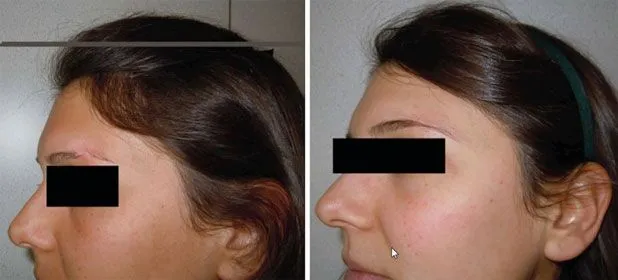
Mesenchymal Stem Cells and Stromal Vascular Fraction for Hair Loss Current Status
What is Growth Factors?
Blood, in addition to red and white blood cells, contains platelets, rich in growth factors and are the most potent healers of the body. Growth factors promote healing by restoring the normal architecture and strength of the tissue.
In a growth factors injection, the patient’s own blood is processed at high speeds (we use the state-of-the-art EmCyte® system), resulting in higher concentrations of the patient’s own platelets with growth and healing factors. These are then injected to promote healing, increase local blood flow, and stimulate hair follicles to grow healthier.

How is Growth Factors used to help the result of a hair transplant?
We see four potential benefits in growth factors when a patient is having a hair transplant. First, it is injected into the FUE or FUG/strip donor area to promote healing and reduce scarring or cobblestoning. Second, each graft prior to being transplanted is “dipped” into the growth factors to promote better regrowth of the hairs.
Third, it is injected into the recipient areas of the scalp (where the grafts get placed) to accelerate healing and potentially improve graft regrowth, particularly in scalps that have scarring whether from a prior transplant or another injury, and also in the crown region where hairs have a tendency to have a lower percentage of regrowth.
Fourth, the growth factors is used to treat hair loss in other areas of the scalp not being transplanted, much as it is used as a stand-alone therapy.
Non-surgical Therapies
And The Doctors
Who Perform Them
In addition to Dr. J. Epstein, we have several experts at Foundation Aesthetic Hair Restoration who provide these treatments.
Andrea Miranda MSN, APRN, FNP-BC, Nurse Practitioner, joined Foundation Aesthetic Hair Restoration in 2018. She received her Bachelor of Science in Nursing from Barry University and Master of Science in Nursing at the University of Miami, where she graduated Summa Cum Laude.
Andrea has earned a name for herself among our hair loss patients, specializing in medical therapies (such as growth factor and Laser Light Therapy) to combat hair loss. Under the guidance and direction of Dr. Jeffrey Epstein, she has become an expert in the use of growth factor. Andrea also serves as an expert on Laser Light Therapy and its benefits for hair loss. Working closely with Dr. J. Epstein on his private-labeled laser cap program, Foundation Light Therapy is one of her passions. Foundation Light Therapy offers specially designed, medical grade laser caps with customized regimens and close follow up by her and Dr. J. Epstein.
In Dr. J. Epstein’s Miami office, your initial consultation will be with Andrea, as she helps to narrow down your concerns, orders and evaluates lab work related to hair loss, performs scalp biopsy when indicated, and helps the process to discover the best way to achieve your hair goals.
Dr. Anthony Bared, a fellowship-trained facial plastic surgeon who studied at the University of Miami and the University of Illinois at Chicago, also performs state of the art hair transplants as well as a variety of non-surgical therapies. He has presented at national meetings on his research into laser light therapy and growth factor and on facial hair transplants.
Dr. Gorana Kuka Epstein is a fellowship-trained plastic surgeon from Europe who has a particular interest in the use of growth factor and mesotherapy for female and male hair loss. Her presence is a real bonus for the Foundation, as in Europe these cutting-edge therapies have been used more intensively than here in North America. She also is conducting research on the use of regenerative cells and fat transfer therapy as a potential treatment for hair loss.
In addition to injecting growth factor as a treatment for hair loss, Dr. J. Epstein along with Dr. Gorana Kuka Epstein perform the procedure of fat transfer. This technique involves injecting fat (combined with growth factor) that is obtained by limited liposuction into areas of hair loss. It has been proven to have some efficacy in treating not only cases of scarring alopecia but also female and male pattern hair loss.
Stem Cells for Hair Loss FAQs
Do I have to worry about the use of blood products?
No, your own blood is used for the growth factors procedure so there is no transfusion risk.
What do I have to do prior to and after having the procedure?
The patient should avoid all anti-inflammatory medications for seven days prior and three days after the procedure. This includes prescription anti-inflammatory medications as well as over the counter naproxen, aspirin, and ibuprofen (cardiac patients should continue taking aspirin). It is fine to take pain relievers like Tylenol (acetaminophen) and narcotics like codeine (if a hair transplant was performed at the same time).
Patients on blood thinners (Coumadin/warfarin/Plavix/Pradaxa) are not candidates for growth factors injections. Right after the growth factors procedure, the patient is fully presentable.
How long does it take?
The entire process takes about 90 minutes. The majority of the time involves drawing and processing the patient’s blood for the injection. The patient is then ideally seen at two and six weeks to access for healing and early results.
What can I expect during the procedure?
Using sterile equipment, approximately 60cc of the patient’s blood is drawn from a vein and placed in a specialized tube to be centrifuged. As the growth factors is being processed, the scalp will be anesthetized using nerve blocks- since local anesthetics can inhibit the growth factors, local anesthetics cannot be injected into the actual areas of the scalp being treated.
It then takes several minutes to inject the growth factors into the affected areas of the scalp. To activate the growth factors, the scalp is then treated with a microneedling with hundreds of tiny microdots made.
If the growth factors is being performed with a hair transplant, at the onset of the procedure the blood is drawn, then the growth factor is prepared then injected into the recipient and donor areas that are already anesthetized, as well as any other areas experiencing hair loss.
What are the complications/risks associated with growth factors?
There are very few risks with the procedure, and all rarely occur. These can include temporary bruising in the area where the blood was drawn or the growth factor was injected, and a temporary worsening of hair loss.
After the procedure, any usually mild discomfort or a headache can be effectively treated with a simple analgesic like Tylenol. You will be presentable right after the treatment.
Are all growth factors treatments the same?
After much research, we have chosen the EmCyte® growth factor system. This system has the best ability to produce the purest, correct concentration of growth factor due to its sophisticated computer technology.
In addition, the ACell helps promote the regenerative activity of the growth factor, so it can be added for an additional fee to the treatment to improve the chances of a positive response. Your patient care coordinator or doctor can answer any other questions you may have.
ACTUAL PATIENT
Contact Us Today
Start Your
Journey
Have questions? Reach out today
for answers and more information.

